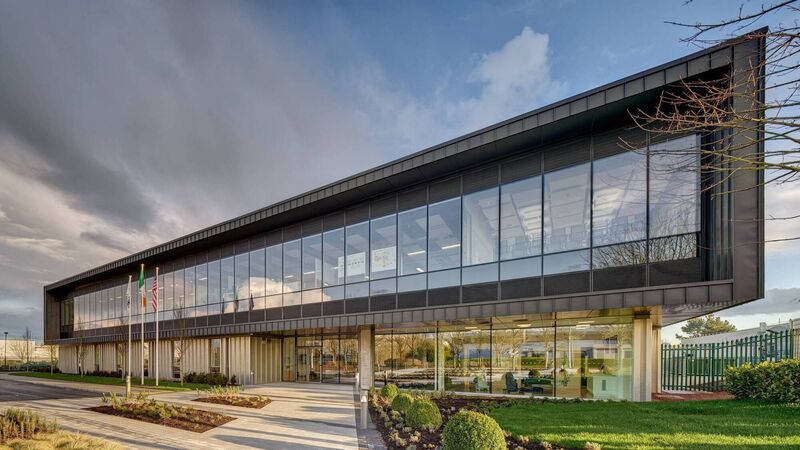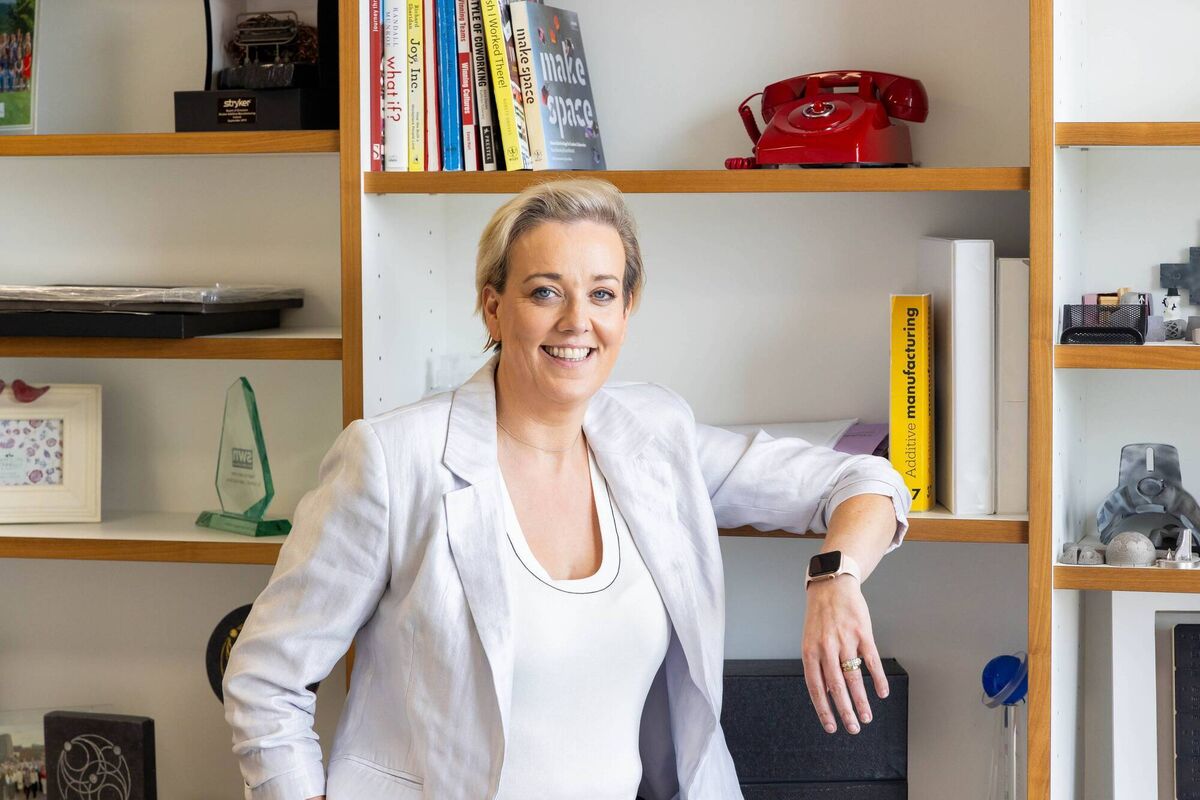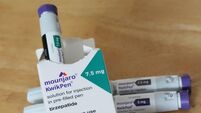Stryker to begin work this year on expanded Cork research centre

Stryker's current Innovation Centre in Carrigtwohill, Co Cork. Work will begin this year to build and expanded the centre over four storeys.
Construction work is expected to commence before the end of this year on Stryker’s major new research and innovation centre in Carrigtwohill, solidifying Cork's position at the heart of the US multinational's global operations.
Despite the global geopolitical changes currently under way, and the fears of the impact on the multinational pharma and medical technology sectors in Ireland, the expansion in Cork by the Michigan-headquartered medical giant highlights the strength of knowledge maintained by facilities here, which cannot be easily replicated elsewhere.
Since opening here in the 1990s, Stryker has expanded operations across Ireland, organically and through acquisitions. Some of its earliest workers, who had roles as operators, today occupy senior positions within the company globally, and Cork is today recognised as a world-leading location for the development of new medical technology devices.
The new facility will significantly expand the operations that first began at the site in 2015. The US multinational has planning permission to expand the current 44,000sq ft facility, which designs, develops and improves a wide range of high-tech surgical tools and instruments, including scalpels, saws, drills, and micro-powered tools, into an expanded, four-storey, 150,000sq ft modern facility.
The tools developed in Carrigtwohill are used in a variety of surgical procedures, including orthopaedic, neurological, and general surgery. The team at the Innovation Centre works with Cork University Hospital and University College Cork on research into brain tumours to identify margins between healthy and cancerous tissue.
The development includes the relocation of an existing car park, rooftop solar panels, signage and minor elevational and internal alterations to the existing building.
Stryker would not comment on the number of jobs that will be created in the expanded centre, but it would enable the creation of additional capacity within the Innovation Centre.
Ireland is now home to Stryker's largest innovation and manufacturing hub outside of the US. It has six manufacturing facilities here, and three innovation centres located in Cork, Belfast and Limerick.

Stryker has about 5,500 workers in Ireland, with 4,000 of these based in Cork.
The Innovation Centre is headed by Cork native Kevin Manley, the company’s senior director of global research and engineering services. Speaking to the , he explained while the facility is located in Cork, it remains a global operation.
“The new building is really designed with the labs and the heart of everything. So if you walk through your first floor, second floor, third floor, at the centre of each of these floors will be big engineering labs with software, mechanical and electrical,” he said.
“When we started R&D back in 2001, in the whole island of Ireland, we had two employees working on R&D. We have grown significantly from there, but we've only grown because of the talent we've been able to hire.
"We get support from the IDA, and it has been attractive in the past to do R&D here, but unless our employees and our teams are delivering, there wouldn't be a continued investment into R&D in Ireland.
Mr Manley said the background of those working on medical innovations was widening.
“Traditionally, it was mechanical engineers. We’re moving more and more towards software, electronics, material science, photonics, around sensing devices. Before it was just hips, knees, spurs, and now it’s power tools.
“The types of products we are developing were really diversified, so the workforce we need to develop those products has diversified as well," he said.

His colleague Mag O’Keeffe is another long-term Stryker staff member, who began working for the company as a technician when it first arrived in Ireland. She is now the vice-president of global additive technologies, and confirmed the US multinational takes a very long-term view of its operations.
"Stryker is in operation for 80 years, and we've been in Ireland for 27 years now. So our employees know that we're here for the long haul. Policies change, economics change, but we are here for the long haul. We will work through any issues that come our way," she said.
“When we deliver for Stryker, they see us here as a place to invest in. Stryker Ireland is really important to ensuring Stryker Corporation is successful," Mr Manley added.
The operations the company operates here run the breadth of medical technology. Stryker in Belfast produces public access defibrillators, which are becoming more commonplace worldwide.
In Limerick, it produces orthopaedic knee replacements and bone cement. In 2020, it acquired Wright Medical and its site in Macroom, which produces products focused on the trauma and extremity (T&E) sector.
In 2011, Stryker acquired part of Boston Scientific's neurovascular business, including its site on the Model Farm Road, which produces stents and coils for stroke treatment.
Alongside the Innovation Centre in Carrigtwohill is Tullagreen, which builds medical implants for joint replacement, spine and T&E. At Springhill, Stryker manufactures instrumentation for various applications.
Across the road from the Innovation Centre is Anngrove, which opened in 2016 and is truly at the cutting edge of medical technology. The facility is one of the largest 3D printing facilities in the world.
On a visit by the , photography was strictly prohibited. The main hall in Anngrove was filled with high-tech laser 3D printers, each using titanium powder to build orthopaedic implants.
Referred to as "additive manufacturing", the product is built up in layers. This contrasts with more traditional subtractive manufacturing, where a product or element is created by cutting away material from a block. A benefit of 3D printing is that it cuts down on waste. Much of the operations in Anngrove are also automated.
While the facility produces various standard products used by surgeons for knee or hip procedures, often on older patients, 3D printing also allows engineers in Cork to create custom, or patient-specific, implants, which are used in more complex procedures, including juvenile oncology cases. The development of the Innovation Centre is seen as another step forward for the company's operations here.
The number of sites and staff across Ireland has resulted in safety incidents in recent years. Most recently, a fire occurred earlier this month at the Tullagreen site.
It follows the tragedy which struck in 2023 when one of two contract staff, who were injured in an explosion while working on the roof of the company’s Anngrove facility, died two months later from his injuries.
This month, trade union Siptu wrote to the firm’s chief executive, Kevin Lobo, in the US asking him to intervene at the highest level in relation to the incidents.
In Cork, Ms O'Keeffe said they were committed to a safe and healthy work environment. "We did have a minor incident last week. It actually reinforced that we have really stringent safety protocols that were executed. The building was evacuated. The emergency services were called but weren't needed. We had to sweep the building to make sure it was safe, and everybody went back to work the same day. Safety is absolutely paramount to us," Ms O'Keeffe said.
Despite the challenges, Stryker remains in growth mode, in Ireland and globally. Over the past three decades, the company's operations here have grown to form a vital part of its operations.
"Ireland is known as a Medtech country. Fourteen of the world’s top 15 medtech companies are in Ireland, so there's a huge network here with good relationships with academia and hospitals," Ms O'Keeffe said.
"It's a pro-enterprise country. There are so many factorial elements that play into all of that, to make you feel confident.”
A collection of the latest business articles and business analysis from Cork.














